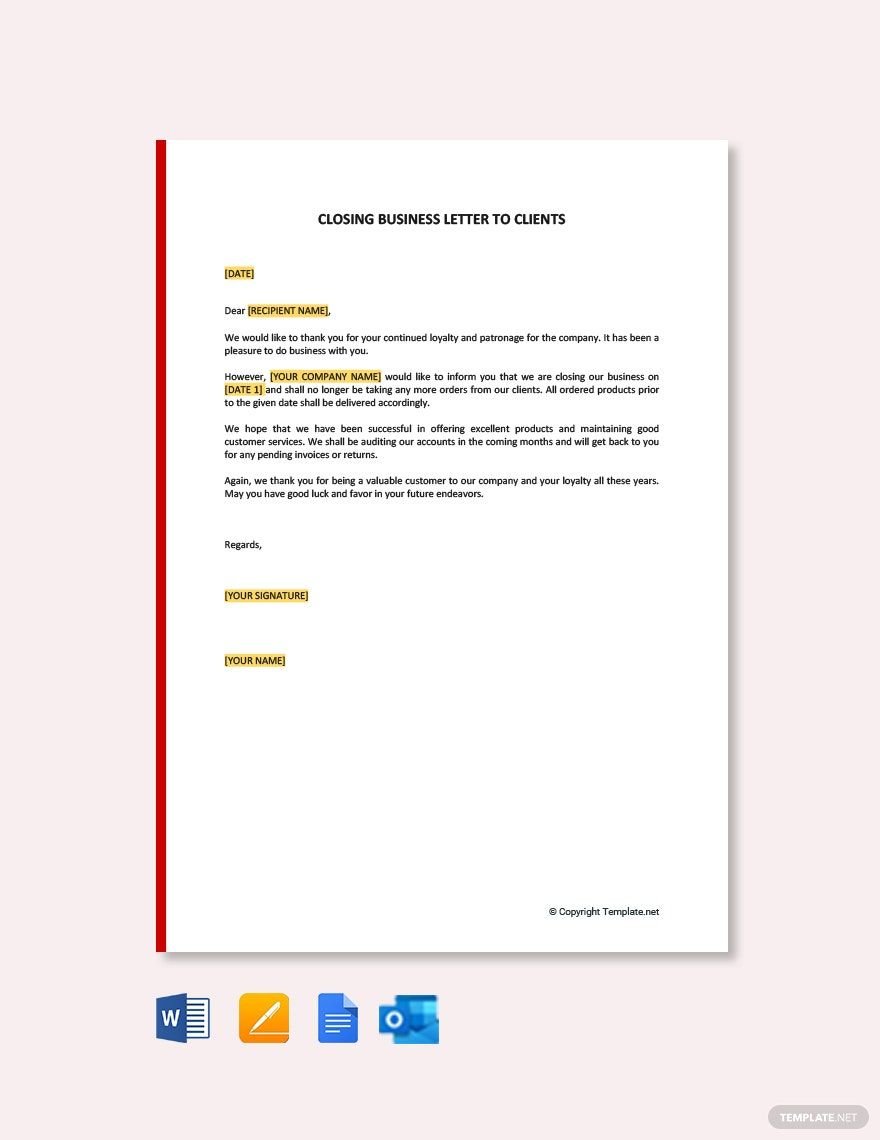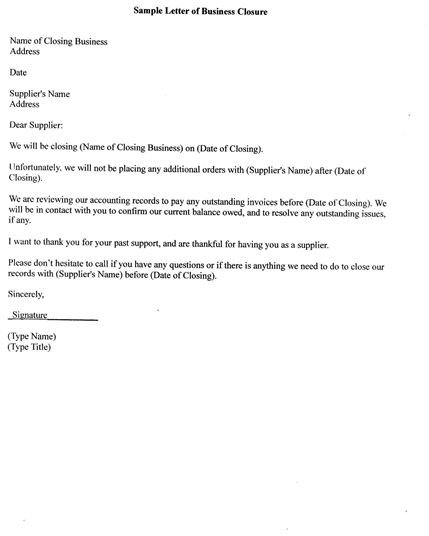It’s a difficult truth: not every business thrives and reaches its full potential. Sometimes, despite dedication and hard work, circumstances force a closure. For those facing this challenging situation, a well-crafted letter of business closure is crucial. This letter serves as a formal announcement to stakeholders, employees, and customers, acknowledging the end of an era while maintaining professionalism and fostering goodwill.

Image: www.template.net
This guide will delve into the key elements of a sample business closure letter, providing insights into its purpose, structure, and crucial considerations. We’ll explore real-world examples, offering practical advice on effectively communicating this sensitive message. With this knowledge, navigating this final step of your business journey can be less daunting, allowing you to focus on moving forward with grace and closure.
Understanding the Importance of a Closure Letter
Imagine walking into your favorite coffee shop, only to find a single sheet of paper on the door announcing its closure. While the message might be clear, it leaves a sense of confusion and a lack of closure. A formal business closure letter addresses this by providing a structured and professional farewell.
Beyond simple communication, this letter serves several vital purposes:
- Official Notice: It formally informs stakeholders about the closure, ensuring transparency and avoiding ambiguity.
- Maintaining Reputation: By outlining reasons for closure in a respectful and concise manner, it helps preserve the business’s reputation.
- Expressing Gratitude: The letter presents an opportunity to thank customers, employees, investors, and other stakeholders for their support throughout the business’s journey.
- Facilitating Closure: It provides a sense of resolution for everyone involved, acknowledging the end of the business in a clear and final manner.
- Providing Guidance: It can offer information regarding any remaining obligations, refund procedures, or contact information for further inquiries.
Essential Elements of a Business Closure Letter
A compelling closure letter goes beyond a simple announcement. It’s a carefully crafted document that balances professionalism, clarity, and sensitivity.
Here’s a breakdown of its key components:
1. Heading and Contact Information
- Company Name: Begin with the company’s official name, clearly stating the entity for which the closure is being announced.
- Date: Include the current date to ensure the letter’s relevance.
- Contact Information: Provide relevant contact information, such as a physical address, phone number, and email address. This allows for follow-up queries and communication.

Image: belogimannabila.blogspot.com
2. Salutation
- Address the Recipient: Start with a formal salutation, addressing the letter to the specific group or individual (e.g., “Dear Valued Customers,” “Dear Employees,” “Dear [Name of Investor]”).
- Maintain Tone: Choose a salutation that matches the overall tone of the letter, conveying a sense of respect and professionalism.
3. Opening Paragraph
- Announce Closure: Begin with a clear and concise statement announcing the closure of the business.
- Express Regret: Briefly express regret about the decision to close, acknowledging this is not an easy step.
- Provide Context: Offer a brief, neutral explanation of the closure’s reason, avoiding unnecessary detail or negativity.
4. Body Paragraphs
- Inform Stakeholders: Provide specific details regarding relevant information for affected parties. For example, address customer refunds, employee severance packages, or investor obligations.
- Express Gratitude: Dedicate a paragraph to expressing sincere appreciation to stakeholders, acknowledging their contributions to the business’s journey.
- Offer Support Information: Include information on how individuals can access further information or contact specific personnel for assistance.
5. Closing Paragraph
- Summarize Closure: Briefly reiterate the closure announcement and express the desire to maintain positive relationships with stakeholders.
- End with Closure: Conclude with a professional closing statement, such as “Sincerely,” “Best regards,” or “Thank you.”
- Company Signature: Sign the letter using the official company name or the name of the authorized representative.
Real-World Examples of Business Closure Letters
To gain further clarity, let’s examine a few real-world examples:
Example 1: Retail Business Closure
[Company Name]
[Date]
[Contact Information]Dear Valued Customers,
It is with heavy hearts that we announce the closure of [Company Name] effective [Date]. We have made this difficult decision after careful consideration and evaluation of various factors.
We deeply appreciate your loyal patronage over the years and are grateful for the trust you placed in us. We are committed to ensuring a smooth transition for our valued customers. We will be accepting returns and offering refunds according to our standard policies until [Date].
We extend our sincere gratitude to our dedicated staff for their hard work and commitment. We wish them all the best in their future endeavors.
Thank you again for your support. We hope you will continue to cherish the memories we shared.
Sincerely,
[Company Name]
Example 2: Online Service Closure
[Company Name]
[Date]
[Contact Information]Dear Subscribers,
After much consideration, we have made the difficult decision to discontinue our online service, [Service Name], effective [Date].
We appreciate the trust you placed in us and the positive feedback we received throughout our journey.
We understand this may come as a surprise. We are committed to providing a smooth transition for our subscribers. All existing subscriptions will be terminated on [Date], and any unused credits will be refunded according to our terms and conditions.
We encourage you to reach out to our support team at [Email Address] or [Phone Number] if you have any questions or concerns.
Thank you for being a part of the [Company Name] community.
Sincerely,
[Name of CEO/Founder]
Sample Letter Of Closure Of Business
Final Thoughts: Leaving a Lasting Impression
While closing a business is never an easy decision, providing a carefully crafted closure letter demonstrates respect for stakeholders and ensures a smooth transition. By addressing the key elements outlined in this guide and adapting the content to your unique circumstances, you can leave a positive final impression.
Remember, this letter is not just about announcing closure; it’s about acknowledging the journey, expressing gratitude, and providing closure for everyone involved. It’s a chance to end your business chapter with grace and professionalism, leaving a lasting impression on those who were part of your journey.






